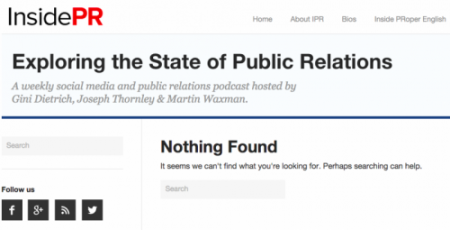Subscribe: Apple Podcasts | Android | RSS
Martin here. And we’re all back.
We start this week with three #IPRMustKnows:
Gini talks about Facebook’s new mobile app, Moments, that searches your camera roll, groups photos together and asks if you want to send them privately to the people in the shots. You can also create Moments for events, vacations, etc. (Of course, it’s not yet available in Canada 🙁 .)
Joe discusses Facebook’s Media Central studio in NYC that coaches celebrities on how to use the platform and live video. He says good enough video isn’t good enough anymore and we should take video streaming seriously, not just wing it. Soon FB will up the ante when they let people broadcast high-quality live video that can be integrated into their own studio control room.
I mention PRSA Counselors Academy. This year, I’m chair of the organization and our annual conference for independent PR agency owners and leaders is May 1 to 3 in San Juan, Puerto Rico. There’s a fantastic program on the business of agency PR including a keynote on creativity from Disney’s Duncan Wardle. Here’s a link for more information or to register.
Our main topic this episode centres on the concentration of digital media and is based on The Game of Concentration by Joshua Benton, a story we read in the Niemen Lab Blog. The author makes the case that journalism used to be spread across North America because you needed a local newsroom to cover local news. With digital, you’d think that would create an even more distributed news world, but the high profile new media companies seem to be clustering in major markets like New York, Washington, LA or Silicon Valley, or Toronto, if you’re in Canada. Which means the media world is getting spikier and not flat. And that’s a challenge to both journalists and PR pros.
We’d love to know what you think.
- What does the future hold for local media and PR practitioners?
- Will people’s interest in the immediate world around them spark a resurgence of local stories and news?
Leave a comment on the blog, send us an email or an audio comment to [email protected], join the FIR Google+ Community, join the Inside PR Facebook group, message us @inside_pr on Twitter, or connect with Gini Dietrich, Joseph Thornley, and Martin Waxman on Twitter. And we have a favor to ask: If you like this podcast, please rate us on iTunes.
******************************************************************
Thank you to the people behind Inside PR. Our theme music was created by Damon de Szegheo; Roger Dey is our announcer. Inside PR is produced by Joseph Thornley.

